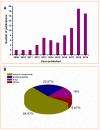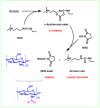Antimicrobial Chitosan Conjugates: Current Synthetic Strategies and Potential Applications
- PMID: 31941068
- PMCID: PMC7013974
- DOI: 10.3390/ijms21020499
Antimicrobial Chitosan Conjugates: Current Synthetic Strategies and Potential Applications
Abstract
As a natural polysaccharide, chitosan possesses good biocompatibility, biodegradability and biosafety. Its hydroxyl and amino groups make it an ideal carrier material in the construction of polymer-drug conjugates. In recent years, various synthetic strategies have been used to couple chitosan with active substances to obtain conjugates with diverse structures and unique functions. In particular, chitosan conjugates with antimicrobial activity have shown great application prospects in the fields of medicine, food, and agriculture in recent years. Hence, we will place substantial emphasis on the synthetic approaches for preparing chitosan conjugates and their antimicrobial applications, which are not well summarized. Meanwhile, the challenges, limitations, and prospects of antimicrobial chitosan conjugates are described and discussed.
Keywords: antimicrobial activity; applications; chitosan; conjugates; synthetic approach.
Conflict of interest statement
The authors declare no conflict of interest.
Figures






References
-
- Pillai C., Paul W., Sharma C.P. Chitin and chitosan polymers: Chemistry, solubility and fiber formation. Prog. Polym. Sci. 2009;34:641–678. doi: 10.1016/j.progpolymsci.2009.04.001. - DOI
Publication types
MeSH terms
Substances
Grants and funding
LinkOut - more resources
Full Text Sources
Research Materials

